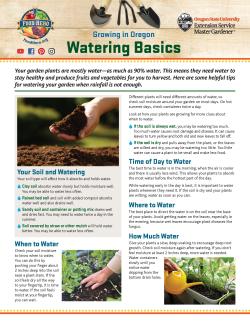Watering Basics
Your garden plants are mostly water—as much as 90% water. This means they need water to stay healthy and produce fruits and vegetables for you to harvest. Here are some helpful tips for watering your garden when rainfall is not enough.
Your Soil and Watering
Your soil type will affect how it absorbs and holds water.
- Clay soil absorbs water slowly but holds moisture well. You may be able to water less often.
- Raised bed soil and soil with added compost absorbs water well and also drains well.
- Sandy soil and container or potting mix drains well and dries fast. You may need to water twice a day in the summer.
- Soil covered by straw or other mulch will hold water better. You may be able to water less often.
When to Water
Check your soil moisture to know when to water. You can do this by pushing your finger about 2 inches deep into the soil near a plant stem. If the soil feels dry all the way to your fingertip, it is time to water. If the soil feels moist at your fingertip, you can wait.
Different plants will need different amounts of water, so check soil moisture around your garden on most days. On hot summer days, check containers twice a day.
Look at how your plants are growing for more clues about when to water.
- If the soil is always wet, you may be watering too much. Too much water causes root damage and disease. It can cause leaves to turn yellow and both old and new leaves to fall off.
- If the soil is dry and pulls away from the plant, or the leaves are wilted and dry, you may be watering too little. Too little water can cause a plant to be small and make less food.
Time of Day to Water
The best time to water is in the morning, when the air is cooler and there is usually less wind. This allows your plants to absorb the most water before the hottest part of the day.
While watering early in the day is best, it is important to water plants whenever they need it. If the soil is dry and your plants are wilting, water as soon as you can.
Where to Water
The best place to direct the water is on the soil near the base of your plants. Avoid getting water on the leaves, especially in the evening, because wet leaves encourage plant diseases like fungus.
How Much Water
Give your plants a slow, deep soaking to encourage deep root growth. Check soil moisture again after watering. If you don’t feel moisture at least 2 inches deep, more water is needed. Water containers slowly until you notice water dripping from the bottom drain holes.
Hand-watering: Use a watering can or garden hose. Water the soil slowly so that it can absorb the moisture deeply. Too much pressure may splash soil on the leaves or wash the soil away.
Sprinkler: Be careful when using a sprinkler on fruits and vegetables. Although it can spread water over a wide area, it may scatter water to places where weeds grow. Also, because it waters from above, it may wet plant leaves and promote plant diseases. Water may also be lost to wind and heat.
Drip and soaker hoses: These types of hoses slowly water the soil near your plant roots while keeping the leaves dry. They can also use less water than hand-watering and sprinklers. You will need to experiment to learn how long to run the water for your plants.
Olla (pronounced oy-ya): An olla is an unglazed clay pot that people have used for centuries to water plants at their roots. The olla is buried in the soil with the opening above the soil surface. It is filled with water from a hose or watering can and covered to keep out bugs and animals. The water seeps through the clay until the soil has the right amount for plants to absorb. Ollas may work well in raised beds with loose and crumbly soil. They will not work as well in clay soil. Newly planted seeds and seedlings will need to be watered from above until their roots are deep enough to reach the olla.
Learn more tips for watering your garden from your local Extension Master Gardener Volunteers. Find your local program online at https://beav.es/N2W




